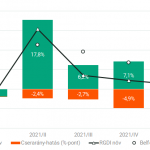Understanding Popular Matchings via Stable Matchings
An instance of the marriage problem is given by a graph $G = (A \cup B,E)$, together with, for each vertex of $G$, a strict preference order over its neighbors. A matching $M$ of $G$ is popular in the marriage instance if $M$ does not lose a head-to-head election against any matching where vertices are voters. Every stable matching is a min-size popular matching; another subclass of popular matchings that always exists and can be easily computed is the set of dominant matchings. A popular matching $M$ is dominant if $M$ wins the head-to-head election against any larger matching. Thus, every dominant matching is a max-size popular matching, and it is known that the set of dominant matchings is the linear image of the set of stable matchings in an auxiliary graph. Results from the literature seem to suggest that stable and dominant matchings behave, from a complexity theory point of view, in a very similar manner within the class of popular matchings. The goal of this paper is to show that there are instead differences in the tractability of stable and dominant matchings and to investigate further their importance for popular matchings. First, we show that it is easy to check if all popular matchings are also stable; however, it is co-NP hard to check if all popular matchings are also dominant. Second, we show how some new and recent hardness results on popular matching problems can be deduced from the NP-hardness of certain problems on stable matchings, also studied in this paper, thus showing that stable matchings can be employed to show not only positive results on popular matchings (as is known) but also most negative ones. Problems for which we show new hardness results include finding a min-size (resp., max-size) popular matching that is not stable (resp., dominant). A known result for which we give a new and simple proof is the NP-hardness of finding a popular matching when $G$ is nonbipartite
Read More: https://epubs.siam.org/doi/abs/10.1137/19M124770X
Nem található esemény a közeljövőben.
A KRTK Közgazdaság-tudományi Intézet teljesítményéről A KRTK KTI a RePEc/IDEAS rangsorában, amely a világ közgazdaság-tudományi tanszékeit és intézeteit rangsorolja publikációs teljesítményük alapján, a legjobb ... Read More »

Tisztelt Kollégák! Tudományos kutatóként, intézeti vezetőként egész életünkben a kutatói szabadság és felelősség elve vezetett bennünket. Meggyőződésünk, hogy a tudomány csak akkor érhet el ... Read More »

Srí Lanka: a 2022-es gazdasági válság leckéje – A. Krueger Lessons from Sri Lanka Anne O. Krueger Jul 25, 2022 – Project Syndicate ... Read More »

A permanens válság korában élünk – J. Meadway We’re living in an age of permanent crisis – let’s stop planning for a ‘return ... Read More »

A 2021 végén, illetve 2022 elején tapaszalt 6, illetve 7%-os cserearányromlás brutális reáljövedelem-kivonást jelentett a magyar gazdaságból. A külső egyensúly alakulásával foglalkozó elemzések többnyire ... Read More »
